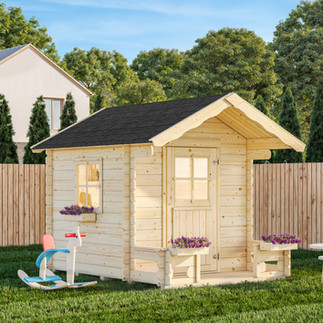Cabin buyer's guide
- Select Haus

- Sep 25
- 4 min read
Updated: Oct 8
Are you dreaming of adding a cozy retreat, a productive home office, or a creative studio to your backyard? A backyard cabin kit can be a fantastic, cost-effective, and often DIY-friendly solution. When exploring our model offerings, it can sometimes feel daunting to decide on the right option for you. Before you hit "buy," take a step back. Consider these key factors to ensure you choose the perfect cabin for your needs.
This guide will help simplify the process. It’s easier than you think!
1. The "Why": Defining the Purpose
This is the most crucial question to ask yourself. What will your cabin be used for?

Home Office: Do you need a quiet space away from the main house to focus on work? Consider the size of your land. What are your electrical needs for computers, lighting, and air conditioning? Also, think about your climate. What degree of insulation is needed for year-round comfort?
Art Studio or Workshop: You'll need good natural light, a sturdy floor, and possibly a ventilation system for fumes or dust.
Guest House: This will require a larger footprint, potentially a bathroom and kitchenette, and a comfortable sleeping area. Be sure to check local regulations.
Gym: You'll need enough floor space for equipment, a strong floor, and a high enough ceiling for exercises like jumping jacks or lifting weights.
Hobby or Storage Shed: If it's just for storage or a workshop, you can choose a simpler, smaller, and less insulated model.
Budget Considerations: Remember to account for the kit, including the roof, sub-frame, and delivery. Don't forget about building costs if you hire a builder, painting, and possibly electrical connections and air-conditioning.
Your intended use will inform almost every other decision you make, from size and layout to insulation and utility connections.
2. The "Where": Sizing Up Your Space
Once you know the purpose, it's time to look at the location.
Measure, Measure, Measure: Don't just eyeball it. Get a tape measure and mark out the exact dimensions of your desired cabin on the ground. Remember to account for roof overhangs, which can add significant width and length. Are there any tree branches in the way?
Consider the Terrain: Is your chosen spot flat and level? If not, you may need to do some groundwork, like pouring a concrete slab or digging a level area. This can add to your costs.
Sun and Shade: Think about the sun's path. Do you want morning sun for a bright art studio or a shaded spot for a cool, relaxing reading nook? This is important for deciding window placement.
Accessibility: Can a delivery truck easily get to the site? Will you need to hire special equipment to move the kit's components from the street to your backyard?
3. The "How": Permits, Regulations, and Utilities
Building a cabin isn't as simple as setting up a tent. You'll need to do your homework.
Local Zoning and Permits: Different states and municipalities have rules about the size, height, and proximity of backyard structures to your property lines. In some cases, you may not need a permit for a smaller cabin, but you'll almost certainly need one for a habitable space with plumbing and electricity. Always check with your local planning department before you buy.
Utility Connections: If your cabin needs electricity, water, or internet, you'll need to plan for trenching and hiring a licensed electrician or plumber. This can be a significant cost.
4. The "What": Kit Type and Quality
Cabin kits are not all created equal. They can vary in materials, construction methods, and completeness. At Select Haus, our quality Nordic spruce kits are complete, and we are realistic about the time required to complete a build.
DIY vs. Professional Build: Are you a seasoned DIYer, or do you plan to hire a professional? Select Haus kits are designed for DIY builds. However, this does require some tools, skill, and effort. Hence, many buyers opt for the services of a professional handyman or builder.
If you have basic skills and are willing to invest some effort, you can save on hiring a tradesman. This can be an excellent way to feel more involved in your project and even involve your whole family in either assembly or the painting of your dream space.
5. Choosing the Right Design
When selecting your cabin, consider the design that best fits your style and needs.
Modern vs. Traditional: Do you prefer a sleek, modern look or a more traditional cabin feel? Each style has its charm and functionality.
Size and Layout: Think about how much space you need. A larger cabin offers more flexibility but may require more maintenance.
Windows and Doors: Natural light can transform your space. Choose windows and doors that enhance the aesthetic while providing functionality.
6. Final Thoughts
Building a backyard cabin is an exciting project. It can enhance your lifestyle and property. By considering the purpose, location, permits, utilities, and design, you can create a space that meets your needs perfectly.
So, are you ready to take the plunge? Your dream outdoor space awaits!








Comments